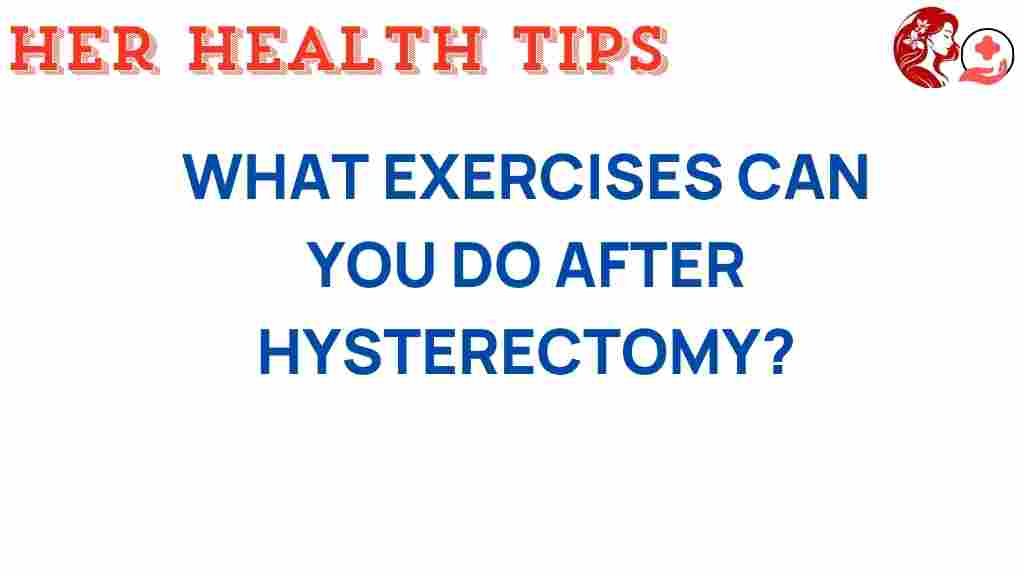Hysterectomy: Post-Operative Exercises for Recovery and Wellness
Undergoing a hysterectomy is a significant life event for many women. While it can be a necessary procedure for various health reasons, the recovery process is crucial for ensuring long-term health and wellness. This article focuses on post-operative exercises that can help you regain strength, improve pelvic health, and enhance overall fitness after your surgery. Embracing a structured rehabilitation plan is essential for your recovery and can significantly impact your quality of life.
Understanding the Importance of Post-Operative Exercises
After a hysterectomy, your body needs time to heal. However, engaging in appropriate physical activity can be beneficial during your recovery. Here’s why post-operative exercises are vital:
- Promotes Healing: Gentle exercises can enhance blood circulation, which is essential for healing.
- Reduces Pain and Discomfort: Movement can help alleviate discomfort associated with surgery and improve your mood.
- Strengthens Core Muscles: Since the abdominal area is affected during a hysterectomy, strengthening these muscles is crucial for recovery.
- Improves Pelvic Health: Targeted exercises can help restore pelvic floor strength, which is vital for bladder control and overall wellness.
- Boosts Confidence: Engaging in physical activity can help you feel more in control of your body post-surgery.
When to Start Post-Operative Exercises
It’s essential to consult with your healthcare provider before starting any fitness regimen post-hysterectomy. Generally, light exercises can begin as early as two weeks after surgery, but this can vary based on individual recovery rates. Listen to your body, and only proceed when you feel ready.
Step-by-Step Guide to Post-Operative Exercises
Here’s a structured plan to help you ease into rehabilitation after your hysterectomy:
1. Gentle Walking
Walking is one of the best initial exercises. It helps improve circulation and gradually strengthens your muscles.
- Start: Begin with short walks around your home.
- Duration: Aim for 5-10 minutes, 2-3 times a day.
- Progress: Gradually increase the duration and distance as you feel comfortable.
2. Deep Breathing Exercises
Deep breathing can help relax your body and promote healing.
- How to do it: Sit or lie down comfortably. Inhale deeply through your nose, allowing your abdomen to expand. Exhale slowly through your mouth.
- Repetitions: Perform this for 5-10 minutes, several times a day.
3. Pelvic Floor Exercises
Strengthening your pelvic floor is crucial for long-term health.
- Kegel Exercises: Contract your pelvic muscles as if you are trying to stop urinating. Hold for 5 seconds, then relax. Repeat 10 times.
- Bridge Exercise: Lie on your back with knees bent. Lift your hips towards the ceiling, squeezing your pelvic muscles. Hold for a few seconds, then lower. Repeat 10-15 times.
4. Core Strengthening
Once you are comfortable, you can start incorporating core exercises.
- Modified Plank: Start on your knees and forearms. Hold your body in a straight line from head to knees for up to 20 seconds.
- Side-Lying Leg Lifts: Lie on your side, lift your top leg while keeping it straight. Hold for a moment, then lower. Repeat 10-15 times on each side.
5. Stretching and Flexibility
Incorporating gentle stretching can enhance flexibility and reduce stiffness.
- Cat-Cow Stretch: On hands and knees, alternate arching and rounding your back for a gentle stretch.
- Seated Forward Bend: Sit with legs extended, reach towards your toes while keeping your back straight.
Troubleshooting Common Challenges
Recovery after a hysterectomy can come with its challenges. Here are some common issues you may face and tips to overcome them:
Pain or Discomfort
If you experience pain during exercises, it’s essential to stop and rest. Consult your healthcare provider if pain persists.
Fatigue
Fatigue is common post-surgery. Ensure you are not overexerting yourself and take breaks as needed.
Emotional Well-Being
It’s normal to feel emotional after a hysterectomy. Consider talking to a therapist or joining a support group for women who have undergone similar experiences.
Incorporating Support
Consider involving a physical therapist specialized in women’s health to guide you through your recovery exercises. They can tailor a program suited to your specific needs.
Conclusion: Embracing Your Post-Hysterectomy Journey
Recovering from a hysterectomy is a journey that involves both physical and emotional adjustments. Engaging in post-operative exercises can significantly contribute to your recovery, enhancing your wellness and overall quality of life. Remember to listen to your body, progress at your own pace, and consult with health professionals when necessary. By embracing physical activity and focusing on your pelvic health, you can unlock a healthier, more active lifestyle post-surgery.
For more resources on women’s health and post-surgery recovery, check out this comprehensive guide. If you have any questions or need support, don’t hesitate to reach out to healthcare professionals.
As you continue on your path to recovery, remember that every step you take is a step towards a healthier future.
This article is in the category Fitness and created by HerHealthTips Team
